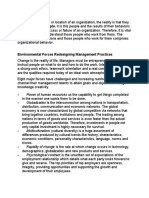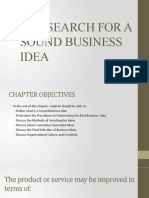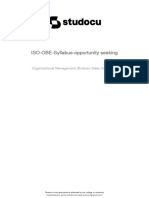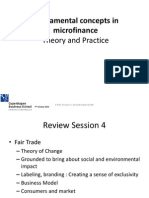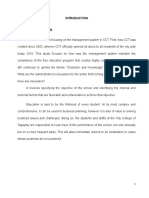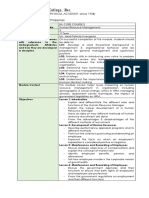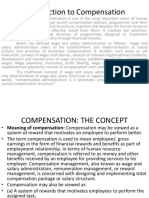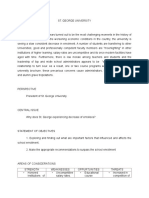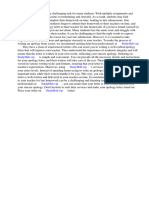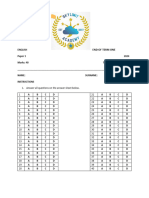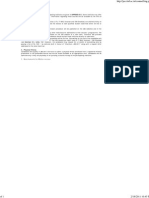ENT 7 - Human Resource Management-ENTREP
ENT 7 - Human Resource Management-ENTREP
Uploaded by
Acesians TagumCopyright:
Available Formats
ENT 7 - Human Resource Management-ENTREP
ENT 7 - Human Resource Management-ENTREP
Uploaded by
Acesians TagumOriginal Title
Copyright
Available Formats
Share this document
Did you find this document useful?
Is this content inappropriate?
Copyright:
Available Formats
ENT 7 - Human Resource Management-ENTREP
ENT 7 - Human Resource Management-ENTREP
Uploaded by
Acesians TagumCopyright:
Available Formats
ACES TAGUM COLLEGE
Mankilam, Tagum City 8100
Province of Davao del Norte, Philippines
Tel. # (084) 400-2099 E-mail: atc_tagum@yahoo.com
BACHELOR OF SCIENCE IN ENTREPRENEURSHIP
ENT 7 – Human Resource Management
Course Syllabus
As of AY 2019-2020
I. INSTITUTIONAL VISION-MISSION STATEMENT
Institutional Vision
Aces envisions to produce technically skillful workforce imbued with the values of entrepreneurship in their own field of choice.
Institutional Mission
In order to realize the vision, Aces shall earnestly pursue and adhere to the principles of applied competence, business incubation,
consistency of work, valuing the fruits of hard labor and believing in the intervention of the divine providence.
It shall promote the dignity of technical skills and recognize the value of such skills demonstrated in the daily lives of the ordinary men
and women who have done extra ordinary jobs in their respective communities.
Institutional Goals
The college in its entire capabilities shall endeavor to:
1. Offer courses of high technical value which enable the graduates to be either employed or self-employed.
2. Provide advance teaching technologies that enhance thorough learning and easy understanding.
3. Establish linkages with the employment sector in order to assist graduates who are seeking employment.
4. Encourage and support graduates who want to establish their own business.
5. Develop existing staff through a sound human resource development program.
6. Provide a wholesome working condition worthy of human dignity.
7. Promote an atmosphere conducive for learning where skills are developed through exposure in the business incubation centers.
8. Recognize graduates and local entrepreneurs who excel in their chosen field and extend appropriate incentive.
9. Promote and develop entrepreneurship program and recognize the value of its contribution in the society.
Page 1 of 9 ENT 7 – Human Resource Management
II. INSTITUTE OF ENTREPRENEURSHIP VISION-MISSION STATEMENT
Institute’s Vision
We educate students to become technically skillful individual characterized with values of entrepreneurship who are socially responsible
and globally oriented in their field of proficiency.
Institute’s Mission
We are dedicated to the development of an integrated person with commitment to achieve their role of leadership in their community,
valuing the fruits of hard labor and believing in the intervention of the Divine Providence.
III. INSTITUTE OF ENTREPRENEURSHIP GRADUATE ATTRIBUTES
Graduates who are:
1. Learning continuously to develop knowledge and skills based on personal initiatives and acceptance of constructive feedback
2. Effective communicators with relevance in terms of context, purpose and audience
3. Critical thinkers to address business problems with strategies in order to generate, interpret and use effective information
4. Effective leaders and collaborators to facilitate the productivity and cohesiveness of work teams
5. Socially responsible in imparting values and principles applied to determine and judge the implications of actions
6. Appropriate information and technology to manage efficiently and effectively
7. Confident and self-motivated with discipline and independent inquiry in using their knowledge and skills to address the challenges
of professional activity
8. Faith Motivated
IV. PROGRAM OUTCOMES COMMON TO ALL TYPES OF SCHOOLS
1. Discuss the latest developments in the specific field of practice. (PQF level 6 descriptor)
2. Communicate effectively using both English and Filipino, orally and in writing.
3. Work effectively and independently in multi-disciplinary and multi-cultural teams. (PQF level 6 descriptor)
4. Exemplify professional, social, and ethical responsibility.
5. Preserve and promote “Filipino historical and cultural heritage”.
V. PROGRAM OUTCOMES COMMON TO ALL ENTREPRENEURSHIP PROGRAMS
1. Use the proper decision tools to critically, analytically, and creatively solve problems and drive results. To equip students with
knowledge, skills and competencies in office administration through innovative instructional exposure.
2. Implement the basic functions of management such as planning, organizing, staffing, directing, leading and controlling.
3. Use information and communication technology (ICT) effectively and efficiently.
4. Work well with others and to inculcate the culture of excellence and instill personal values and professional business ethics.
5. To mold socially responsible professionals through participation in research-based extension services.
Page 2 of 9 ENT 7 – Human Resource Management
VI. COURSE INFORMATION
Course Code & Title: ENT 7 – Human Resource Management
Number of Units: 3 Units
Prerequisite: ENT 2
Year/Semester Offered: Third Year/First Semester
Number of 5 Hours per week (10 Weeks – 20 Sessions)
Weeks/Sessions:
Laboratory: None
Course Description: This course covers essentially the various approaches and techniques in training and education human
resources in organizations the course revolves around a framework of designing, implementing and
evaluation training programs using various HRD concepts.
Course Intended Learning At the end of the course, the students must be able to:
Outcomes: 1. Be aware of the currents and practices of personnel and human resource management towards the
changing global trends and emerging new world in the business external and internal environment.
2. Identify themselves as part of the human resources in the future to compete; perhaps they themselves
adopt the new concepts to put into practice the principles towards global competence.
3. Familiarize with the current concept applied in personnel and human resources management and
internalize the concept to express thought and ideas by learning the skills to b confident in the
application.
Course Requirements: Reports
Activity Notebook( exercises, quizzes, assignment)
Lesson Notebook
Term Paper ( actual interview in selected business industries)
Actual Demonstration (Human Resource Management)
Case Analysis
Grading System: Periodical Examination 35%
Quizzes 25%
Participation 10%
Assignment 10%
Project 10%
Attendance 10%
Page 3 of 9 ENT 7 – Human Resource Management
References: Azanza, P. A. (2000) Human Resource Management. Quezon City: JMC Press Inc.
Andres, T. D. (1991) Human Resource Management in the Philippine Setting. Quezon City: New Day
Publisher
(1980) Human Resource Training and Development. Quezon City: New Day Policy
Martines, C. R. (1999) Human Resource Management: Principles and Practices 3rd Edition. Mandaluyong
City: National Bookstore
Sison, P. S. (2000) Personnel Management in the 21st Century. 7th Edition. Manila: Rex Book Store
(1991) Personnel and Human Resource Management. Manila: Rex Books Store
http://www.managementhelp.org/hr_mgmnt/hr_mgmnt.htm
http://www.en.wikipedia.org./wiki/human_resource_management
http://books.google.com.ph/books
VII. COURSE OUTLINE
Time Intended Learning Course Content/ Teaching and Learning Assessment Tasks Resource Textbooks/
Frame Outcomes (ILO) Subject Matter Activities (TLAs) (ATs) Materials References
Week After having been given I. An Overview of Introductory Activity: Quiz Marking Pens Syllabus
1&2 a basic orientation of Human Resource Orientation: Let the students
the whole course and Management to introduce themselves in Actual Photocopies Student
Presentation of
discussion, the a) The Human one or two words. of the Lesson Handbook
each group
students must be able Resource Self-Assessment
to: Functions of Questioners for every Assignment for Calculator Human
1. Call each other on Management chapter. the next Resource
the first name basis. b) Human discussion Management
2. Practice the Resource Input: by Azanza P.
classroom rules and
Planning Review of the classroom Board Work A. Chapter 1&2
note the periodical policies and the rules and
exams as well as Human
regulation of the school. Resource
the grading system
Discussion of the grading Management in
3. Give the scope of
human resource system, course outline, the Philippine
management course requirements Setting, T. D.
Discussion/ Human
4. Identify the Lecture Resource
personnel and
Page 4 of 9 ENT 7 – Human Resource Management
policies and discuss Application: Training and
their importance to Students will answer the Development
human resource problems (case analysis) by Andres, T.
management
given by the instructor. D.
Actual presentations of each Human
group. Resource
Interview a personal/ human Management
resources manager on his Principles &
concept on the nature, Practices 3rd
scope and role of human Edition by
resource management. Do Marines, C. R.
you agree with him? Personnel
Explain. Is his concept Management in
similar to that of the the 21st
management of his Century by
organization? If not, ask him Sison, P. S.
how differences are settled. Personnel and
Valuing activity: Human
Reaction Paper Resource
“ The only resource which Management
can have an output greater by Sison, P. S.
than the sum of its part is
the human resource”
PRELIM EXAM
Week 3 At the end of the week, II. Functions of Introductory Activity: Quiz Marking Pens Syllabus
&4 the students must be able Human Resource Self-Assessment
to: Management Questionnaires for every Actual Laptop Human
Presentation of
1. Distinguish the job chapter Resource
each group
description from job a) Job Analysis Input Reference Management by
analysis and explain and Discussion/ Lecture Book Azanza P. A.
Assignment for
their uses to human
Specification the next Chapter 3,4&5
resources Application:
development. b) Recruitment, discussion Calculator
Students will answer the
Page 5 of 9 ENT 7 – Human Resource Management
2. Give the meaning of Selection and problem (case analysis) to Board Work Human
job specification and Specification be given by the instructor. Resource
discuss its c) Personnel Actual presentations of the Management in
differences with job
Orientation, problems given to each the Philippine
analysis and
description. Integration and group. Setting, T. D.
3. Explain the steps in Training Secure a job description
the recruitment, and a job specification Human
selection and hiring from a private organization Resource
or personnel and and from government Training and
discuss the selection agency. Critique each. Development by
programs of some
Write on top of the job Andres, T. D.
companies.
4. Identify and explain description and job
the factors that specification the name, Human
influence employees type, size and age of the Resource
efficiency and organization. Management
effectiveness in his Interview a manager of a Principles &
work performance human resources department Practices 3rd
5. Discuss the meaning of each private and public Edition by
of training and give organization on the following
some basis of rating Marines, C. R.
aspects:
the personnel
Sources used for
performance recruitment Personnel
Budget allocation for Management in
recruitment the 21st Century
Problems met in by Sison, P. S.
recruitment, screening,
selection and placement.
Personnel and
Valuing Activity: Reaction Human
Paper Resource
Evaluate yourself in your
performances (home, Management by
school and with friends) Sison, P. S
MIDTERM EXAM
Page 6 of 9 ENT 7 – Human Resource Management
Week At the end of the week, III. Functions of Introductory Activity: Quiz Marking Pens Syllabus
5&6 the students must be able Human Resource Self-Assessment
to: Management questionnaires for every Actual Reference Human
Presentation of
1. Point out the chapter. Book Resource
each group
importance of a. Employee Management by
performance Compensation Input: Laptop Azanza P. A.
Assignment for
evaluation to b. Performance Discussion/ Chapter 6, 7, 8
the next
production and wage Appraisal Lecture discussion Calculator &9
salary administration c. Employee Application:
2. Prepare an incentive Benefits and Board Work Human
Students will answer the
plan and salary Retirement problems (case analysis) to Resource
scheme. d. Career be given by the instructor. Management in
3. Define what are fringe Planning, Actual presentations of the Philippine
benefits Guidelines and each group. Setting by
4. Identify and evaluate Development Interview a manager of a Andres, T. D.
guidelines in granting human resources department
fringe benefits and ask if he evaluates any of Human
5. Explain the different their training programs. If so, Resource
ways of moving inquire about the process they Training and
employee’s use and its results. Development by
promotion, demotion Role playing Andres, T. D.
transfer and Valuing Activities: Reflection Human
separation. Paper Resource
How will you direct yourself it Management
towards your career? Principles &
Practices 3rd
Edition by
Marines, C. R.
Personnel
Management in
the 21st Century
by Sison, P. S.
Page 7 of 9 ENT 7 – Human Resource Management
Personnel and
Human
Resource
Management by
Sison, P. S
Week At the end of the week, IV. Labor Introductory Activity: Quiz Marking Pens Syllabus
7&8 the students must be able Management Self-Assessment
to: Relations questionnaires for every Actual Reference Human
Presentation of
1. Identify and discuss a. Due Process chapter. Book Resource
each group
common complaints and Just Cause Management by
and grievance of b. Reasons for Input: Laptop Azanza P. A.
Board Work
employees. Unions Discussion/ Chapter 10
2. Point out some causes Formations and Lecture Calculator
Membership
of grievances and ways c. Fair Treatment Application: Human
of handling these. of Labor Union Students will answer the Resource
3. Give the meaning or d. Collective problems (case analysis) to Management in
morale and motivation Bargaining be given by the instructor. the Philippine
and discuss their Process Setting by
Actual presentations of
importance to business e. Union Andres, T. D.
Organizing each group.
operation. Interview a manager of a
Procedures
4. Enumerate the f. Collective human resources department Human
functions of human Bargaining and ask about unionism, f Resource
resource manager and Process there is any, in their Training and
explain how these g. The Grievance organization. Development by
levels be relevant in Procedure Role playing Andres, T. D.
solving union problems. h. Employee Human
Separation Valuing Activities: Reflection
5. Identify and discuss the Resource
Paper
different reasons why Management
How will you manage
employees join union. Principles &
yourself towards situations
6. Explain the importance Practices 3rd
in your life?
of a health program to Edition by
Page 8 of 9 ENT 7 – Human Resource Management
the workers as well as Marines, C. R.
its benefits to the
management. Personnel
Management in
the 21st Century
by Sison, P. S.
Personnel and
Human
Resource
Management by
Sison, P. S
FINAL EXAM
XI. CLASSROOM POLICIES
1. Prayer. Each class begins and ends with a prayer.
2. Civility. Students ought to show politeness and respect to the teacher in the class.
3. Set Policies at the Beginning of the Course. In particular, make sure attendance and grading policies are clear, preferably in
writing.
4. Promptness. Students are expected to come to class on time, 15 minutes late is considered absent.
5. Attendance. Regular attendance is required from all students. Maximum absences excused or unexcused, should not more than 20%
of the total number of class hours required. Any student who exceeds the number of absences allowed shall be denied of academic
credit. Only legitimate reasons are acknowledged to class.
6. Proper and Complete Uniform. Students are expected to wear proper and complete school uniform upon entering the class.
7. Participation. Participation in class (no side discussions). Contribute to the class discussion when appropriate.
8. Intellectual Integrity. Be honest with yourself; be honest with your sources. Avoid plagiarism.
9. Use of Cell phones and other Electronic Devices. Cell phones and other electronic devices will be turned off prior to the start of the
class or place on vibrate during the class.
10. Energy Conservation. Lights and fans are turned off every after class. Conservation can be form of regulation.
11. Submission of Requirements. “You may delay, but time will not”. Submit all requirements on time.
12. Courtesy. Being polite and courteous is the key that opens doors. Show respect for others at all times.
Page 9 of 9 ENT 7 – Human Resource Management
You might also like
- The Complete Masonic LibraryDocument10 pagesThe Complete Masonic LibraryStormey Becoolnow100% (2)
- Office System Mamanagement: in Tne GovernmentDocument45 pagesOffice System Mamanagement: in Tne GovernmentVincent BernardoNo ratings yet
- 69547314Document3 pages69547314Jasmin GabitaNo ratings yet
- CHAPTER 3 From Exposure To ComprehensionDocument15 pagesCHAPTER 3 From Exposure To ComprehensionRuby De GranoNo ratings yet
- Human Resource Management - 101Document34 pagesHuman Resource Management - 101Elena-Maria SzakacsNo ratings yet
- ENTREP Perspective On EntrepreneurshipDocument20 pagesENTREP Perspective On EntrepreneurshipJack ColeNo ratings yet
- New - OBTL Modular Principles of Management and Organization - First SemesterAY2020-2021Document4 pagesNew - OBTL Modular Principles of Management and Organization - First SemesterAY2020-2021rebecca lising100% (1)
- Examples of Corporate Social ResponsibilityDocument6 pagesExamples of Corporate Social ResponsibilityRebecca Chanice AcohonNo ratings yet
- ECC 2 - Intro To Programs and Policies in Enterprise DevelopmentDocument28 pagesECC 2 - Intro To Programs and Policies in Enterprise Developmentrommel.diesta100% (1)
- Marketing Management Module 3Document14 pagesMarketing Management Module 3Sharon Cadampog Mananguite0% (1)
- OBE Org DEv SyllabusDocument8 pagesOBE Org DEv SyllabusKaren GayNo ratings yet
- Module Week 4 Entrep For UploadDocument5 pagesModule Week 4 Entrep For Uploadゔ違でStrawberry milk100% (1)
- ACCM01B Costing and Pricing-1Document3 pagesACCM01B Costing and Pricing-1Lylanie Gustilo AlcantaraNo ratings yet
- Lesson 1 - Introduction To Retail ManagementDocument3 pagesLesson 1 - Introduction To Retail Managementdelossantosjefferon24No ratings yet
- Training Evaluation - PPT 6Document29 pagesTraining Evaluation - PPT 6ERMIYAS TARIKUNo ratings yet
- Strategic-Management, ProductionOperations Concerns When Implementing StrategiesDocument12 pagesStrategic-Management, ProductionOperations Concerns When Implementing StrategiesJerome ReyesNo ratings yet
- Business Policy SpecificDocument42 pagesBusiness Policy SpecificManish SinghNo ratings yet
- Mark40033 Environmental-Marketing PDFDocument70 pagesMark40033 Environmental-Marketing PDFJustine TecsonNo ratings yet
- Three Dimensional Aspects of Corporate Social Responsibility PDFDocument14 pagesThree Dimensional Aspects of Corporate Social Responsibility PDFKhudadad NabizadaNo ratings yet
- Illustrative CasesDocument9 pagesIllustrative CasesTehmina Qazi0% (2)
- Organizing, Directing, and Controlling The SmallDocument19 pagesOrganizing, Directing, and Controlling The SmallGerah Duran PasaolNo ratings yet
- Gate-1 Preparation:: Money, Model and MentorsDocument21 pagesGate-1 Preparation:: Money, Model and MentorsStephanie AndalNo ratings yet
- The Concept Evaluation SystemDocument5 pagesThe Concept Evaluation SystemIndri Novita KeumalaputrieNo ratings yet
- Tracer Study Business MarketingDocument5 pagesTracer Study Business MarketingXavel Zang100% (2)
- 5b-The Importance of ManagementDocument33 pages5b-The Importance of ManagementShwetaRevankarNo ratings yet
- Chapter 4 - HRDocument11 pagesChapter 4 - HRMhaii Teradaira50% (2)
- Opportunities and Challenges Among Food Cart Franchise BusinessDocument41 pagesOpportunities and Challenges Among Food Cart Franchise BusinessKristel Anne AquinoNo ratings yet
- Gate 3 - Execution - Machinery, Methods, and Management SkillsDocument35 pagesGate 3 - Execution - Machinery, Methods, and Management SkillsJohn Nelo MorataNo ratings yet
- Environmental Forces Redesigning Management PracticesDocument7 pagesEnvironmental Forces Redesigning Management Practiceskateangel ellesoNo ratings yet
- Chapter 2 - Retail Strategic Planning and Operations ManagementDocument23 pagesChapter 2 - Retail Strategic Planning and Operations ManagementLoren SalanguitNo ratings yet
- Chapter 1 - What Is Organizational BehaviorDocument10 pagesChapter 1 - What Is Organizational BehaviorJason LimNo ratings yet
- Chapter 5. The Search For A Sound of Business IdeaDocument3 pagesChapter 5. The Search For A Sound of Business IdeaMais De KapeNo ratings yet
- 3.chapter1-Opportunity SeekingDocument14 pages3.chapter1-Opportunity SeekingAben Ger SimapanNo ratings yet
- 5 The Search For A Sound Business Idea 1Document24 pages5 The Search For A Sound Business Idea 1Baila BakalNo ratings yet
- Chap 5 Programs and PoliciesDocument6 pagesChap 5 Programs and PoliciesJenalyn floresNo ratings yet
- BAHR 213 - Week 1-2Document15 pagesBAHR 213 - Week 1-2Prescious Joy DonaireNo ratings yet
- Entrep Course Syllabus 2019 2020Document7 pagesEntrep Course Syllabus 2019 2020api-519016653No ratings yet
- Pricing Strategy Chapter 2 2Document16 pagesPricing Strategy Chapter 2 2Elmer John BallonNo ratings yet
- Prospect's Observation Guide: Approach TacticsDocument3 pagesProspect's Observation Guide: Approach TacticsJewel Colleen CardenasNo ratings yet
- Iso Obe Syllabus Opportunity SeekingDocument12 pagesIso Obe Syllabus Opportunity SeekingPatrick ManatadNo ratings yet
- Microfinance Theory and PracticeDocument23 pagesMicrofinance Theory and PracticeAnirudh AgrawalNo ratings yet
- Module 1 SesconDocument11 pagesModule 1 SesconKissy LorNo ratings yet
- Chapter 4 To 6 (Merge)Document35 pagesChapter 4 To 6 (Merge)KENNETH IAN MADERANo ratings yet
- Strategy and National DevelopmentDocument35 pagesStrategy and National DevelopmentelmarcomonalNo ratings yet
- ReflectionDocument1 pageReflectionashley100% (1)
- Service CultureDocument35 pagesService CultureDawit TesfayeNo ratings yet
- Final Term PaperDocument39 pagesFinal Term PaperNiña Manaig Avilla - PapaNo ratings yet
- BA CORE COURSE 5 Human Resource Management (Module)Document3 pagesBA CORE COURSE 5 Human Resource Management (Module)Arven FrancoNo ratings yet
- Ch.13 Managing Small Business FinanceDocument5 pagesCh.13 Managing Small Business FinanceBaesick MoviesNo ratings yet
- Topic - 3 (Management Function - Staffing)Document6 pagesTopic - 3 (Management Function - Staffing)Saffa IbrahimNo ratings yet
- Chapter 1 OPerations Management and Value ChainDocument31 pagesChapter 1 OPerations Management and Value ChainNadine Lumanog100% (2)
- Module 5Document18 pagesModule 5Sarthak YadavNo ratings yet
- Ethical and Social Responsibilities of The EntrepreneurDocument9 pagesEthical and Social Responsibilities of The Entrepreneurtopherski100% (2)
- Business Location and Success:: The Case of Internet Café Business in IndonesiaDocument22 pagesBusiness Location and Success:: The Case of Internet Café Business in IndonesiaRichard Rhamil Carganillo Garcia Jr.100% (1)
- College of Business, Entrepreneurship and Accountancy: Cagayan State UniversityDocument17 pagesCollege of Business, Entrepreneurship and Accountancy: Cagayan State UniversityZetZalunNo ratings yet
- C & B Module 1 - Introduction To CompensationDocument15 pagesC & B Module 1 - Introduction To CompensationRuturaj patilNo ratings yet
- CHED PUBLIC Orientation On New Policies Standards and GuidelinesDocument43 pagesCHED PUBLIC Orientation On New Policies Standards and GuidelinesCarlo CornejoNo ratings yet
- Lesson 1 The Domain of Production and Operations ManagementDocument10 pagesLesson 1 The Domain of Production and Operations ManagementJan Miguel LandinginNo ratings yet
- Orge University. AnjieDocument4 pagesOrge University. AnjieKim Kyun SiNo ratings yet
- Ch. 1 Introduction To Management and OrganizationDocument26 pagesCh. 1 Introduction To Management and OrganizationAbood Alissa100% (1)
- Kitchen Stock SheetDocument13 pagesKitchen Stock Sheetmichael nderituNo ratings yet
- Apology Letter To Teacher For Late HomeworkDocument4 pagesApology Letter To Teacher For Late Homeworkafmtjyvdv100% (1)
- CHBEA-STYLE-GUIDE-2021.docx 2078-05-23Document12 pagesCHBEA-STYLE-GUIDE-2021.docx 2078-05-23592sw4dgw6No ratings yet
- Dumpster Dive ArticleDocument2 pagesDumpster Dive Articleapi-298614855No ratings yet
- Employee Data Sheet As of June 21, 2023Document90 pagesEmployee Data Sheet As of June 21, 2023Marie Anne RemolonaNo ratings yet
- Ethics Finals ReviewerDocument10 pagesEthics Finals ReviewerMae MaambongNo ratings yet
- English Paper 1 JCDocument11 pagesEnglish Paper 1 JCtmoatshe96No ratings yet
- Download full Colonial Exploitation and Economic Development The Belgian Congo and the Netherlands Indies Compared 1st Edition Ewout Frankema ebook all chaptersDocument84 pagesDownload full Colonial Exploitation and Economic Development The Belgian Congo and the Netherlands Indies Compared 1st Edition Ewout Frankema ebook all chaptersabecoolenca13100% (3)
- Kuratko 8e Chapter 09Document11 pagesKuratko 8e Chapter 09MangoStarr Aibelle VegasNo ratings yet
- Negotiation Practice On Book Publishing - Nedwin - CourseraDocument2 pagesNegotiation Practice On Book Publishing - Nedwin - CourseraedwinNo ratings yet
- Chapter - 4: Diasporic Predicament of Identity Crisis and Alienation in The NamesakeDocument38 pagesChapter - 4: Diasporic Predicament of Identity Crisis and Alienation in The NamesakeParthiban PNo ratings yet
- Te Reo o Te Repo Voice of The Wetland Complete Book PDFDocument212 pagesTe Reo o Te Repo Voice of The Wetland Complete Book PDFsharon_t_kemp100% (1)
- United States Housing Market CorrectionDocument7 pagesUnited States Housing Market CorrectionPuneet ButaneyNo ratings yet
- JUAN PONCE ENRILE v. SANDIGANBAYANDocument4 pagesJUAN PONCE ENRILE v. SANDIGANBAYANCandelaria QuezonNo ratings yet
- JEE11 Counsellin&AdmsnDocument1 pageJEE11 Counsellin&AdmsnIndiaresultNo ratings yet
- Parte Trasera Del BL MiamiDocument1 pageParte Trasera Del BL MiamiHugo Carrera100% (2)
- StatCon CasesDocument123 pagesStatCon CasesTishreen Mariam I. Bahjin100% (1)
- The Johns Hopkins University PressDocument35 pagesThe Johns Hopkins University Pressnajib yakoubiNo ratings yet
- Sir M. Visvesvaraya Institution of Technology BangaloreDocument13 pagesSir M. Visvesvaraya Institution of Technology BangaloreNithya Raj100% (1)
- Ordinance Urinating NewDocument2 pagesOrdinance Urinating NewMarites RagadiNo ratings yet
- (Tourist Behaviour and The Contemporary World) Contents PDFDocument2 pages(Tourist Behaviour and The Contemporary World) Contents PDFJoya PaulNo ratings yet
- Region 1 5 Car NCRDocument5 pagesRegion 1 5 Car NCRFlorrie Jhune BuhaweNo ratings yet
- Business Plan of Restaurant in Pakistan PDFDocument6 pagesBusiness Plan of Restaurant in Pakistan PDFl1d0pyfafoh3100% (1)
- Mali Delegates Final ListDocument18 pagesMali Delegates Final ListVincsNo ratings yet
- UCS Unite Communication Server CM 92761EN MDocument162 pagesUCS Unite Communication Server CM 92761EN MtotoNo ratings yet
- CIBC Retail Banking - Branch Platform Project and Engagement Best PracticesDocument24 pagesCIBC Retail Banking - Branch Platform Project and Engagement Best Practicesrohit7853No ratings yet
- Cost Monitoring: Presented by Somayo Varam 7 Semester, Civil MITDocument13 pagesCost Monitoring: Presented by Somayo Varam 7 Semester, Civil MITVARAM'S ENTERTAINMENTNo ratings yet
- 07 - CBL21001 - SOW - NLD Reefer Containers - v2.1Document87 pages07 - CBL21001 - SOW - NLD Reefer Containers - v2.1TK2No ratings yet
- Accomplishment Report AUGUSTDocument6 pagesAccomplishment Report AUGUSTJunrey De La CruzNo ratings yet




























